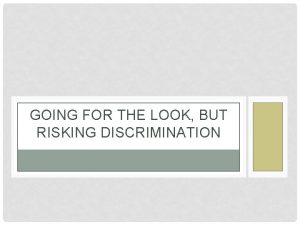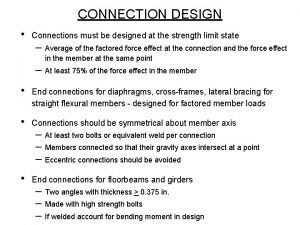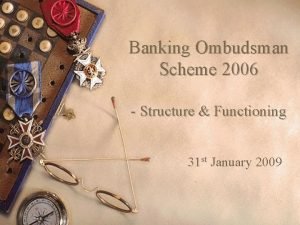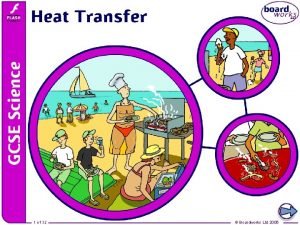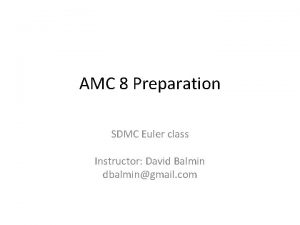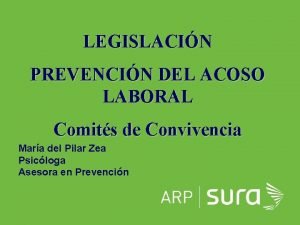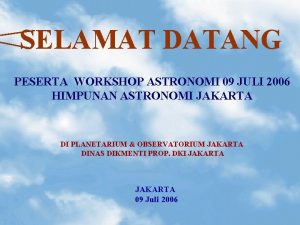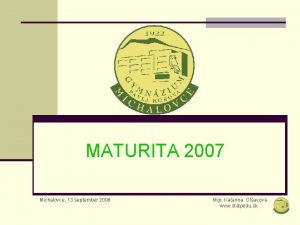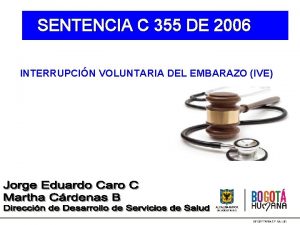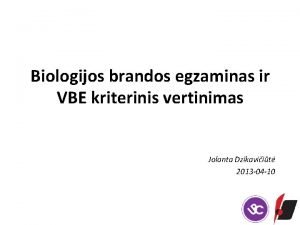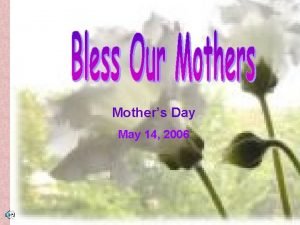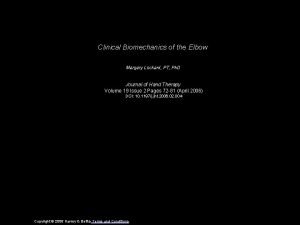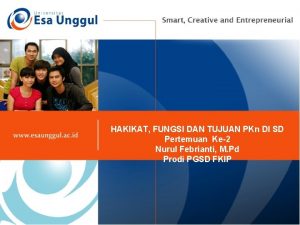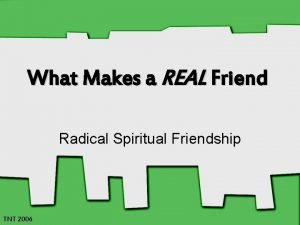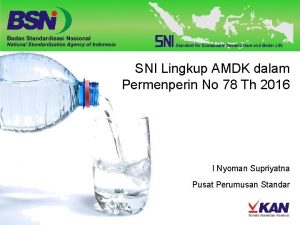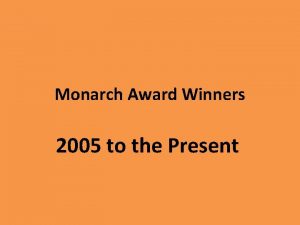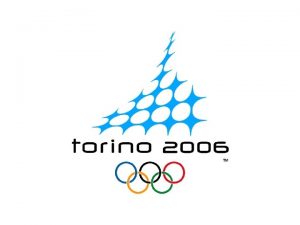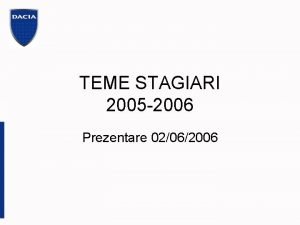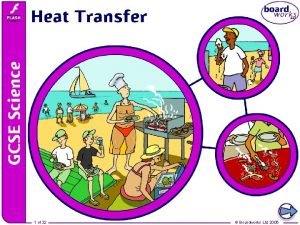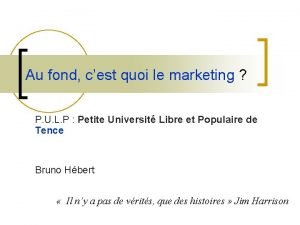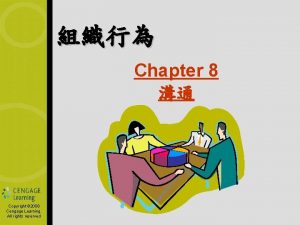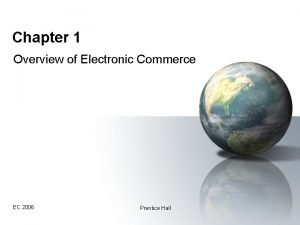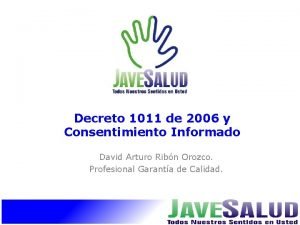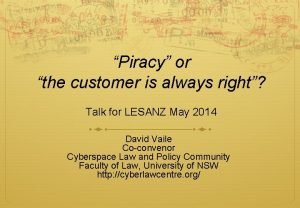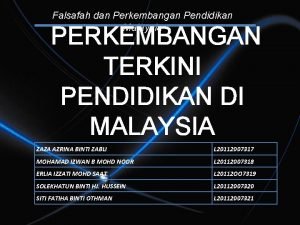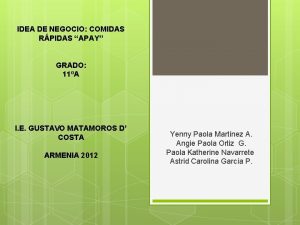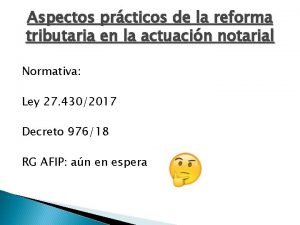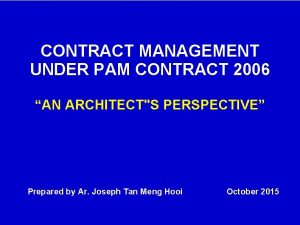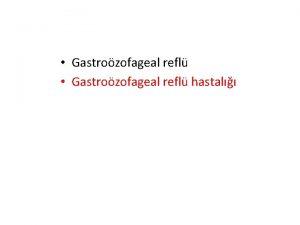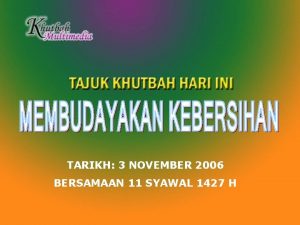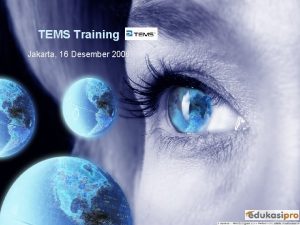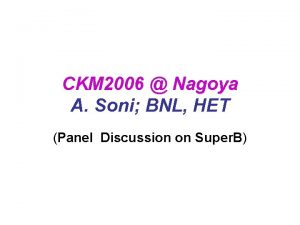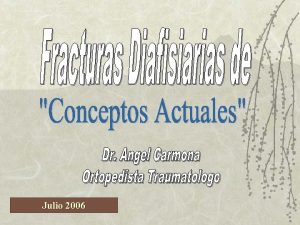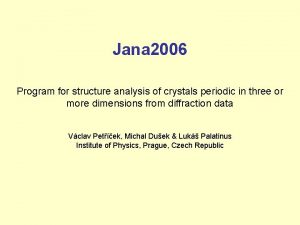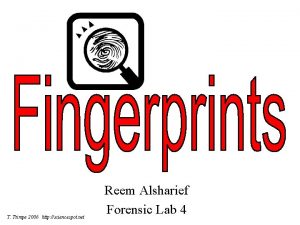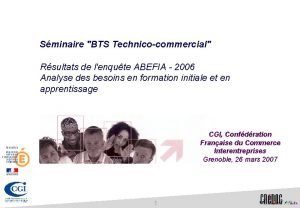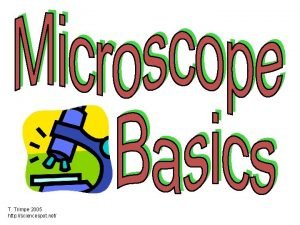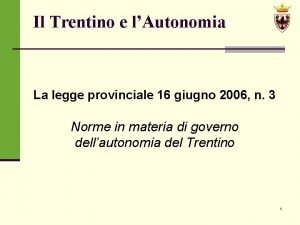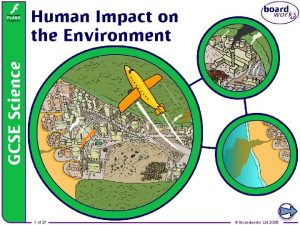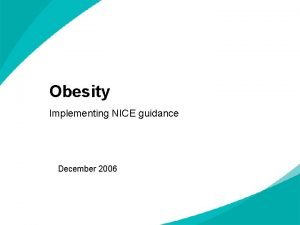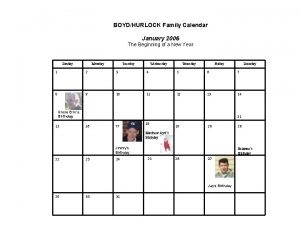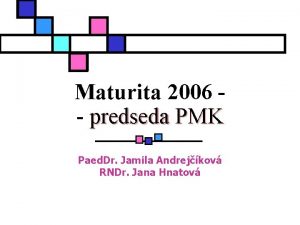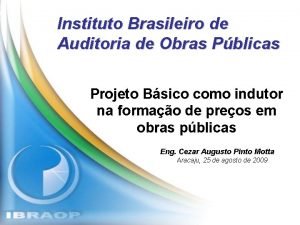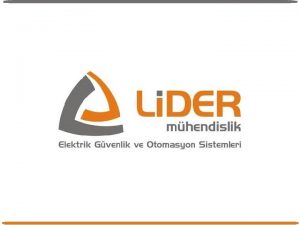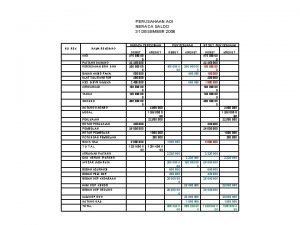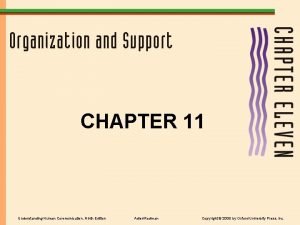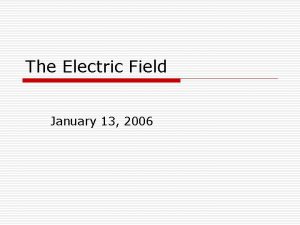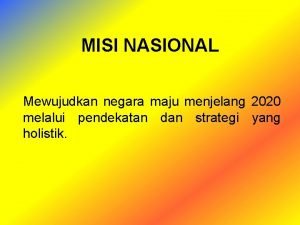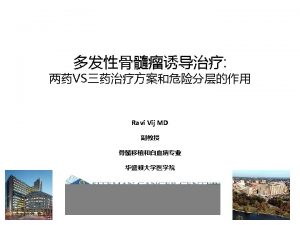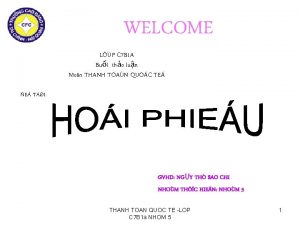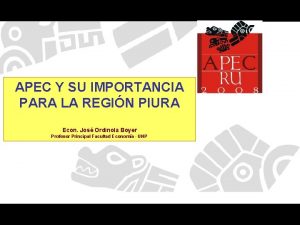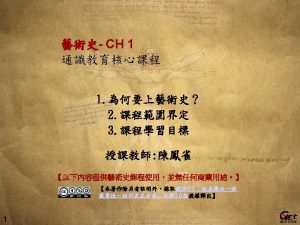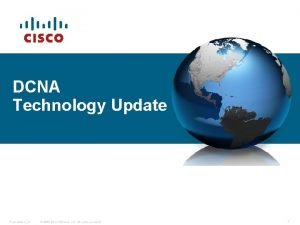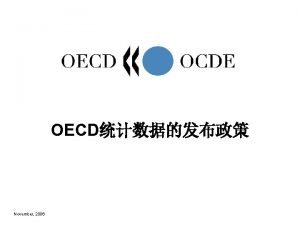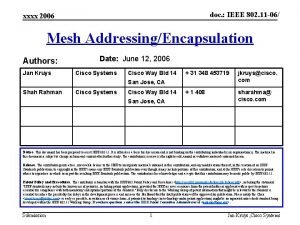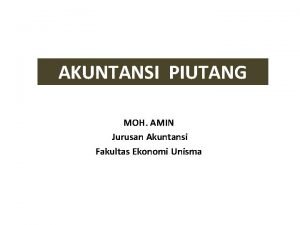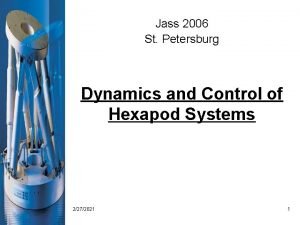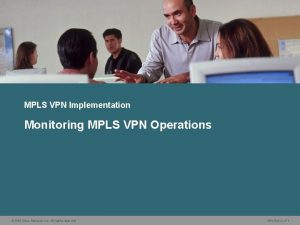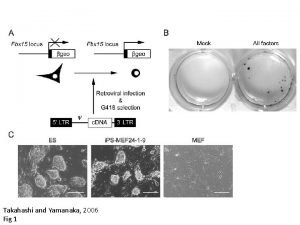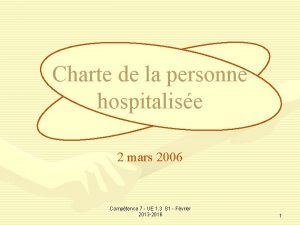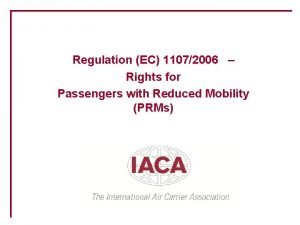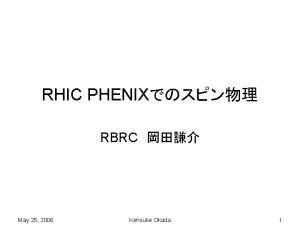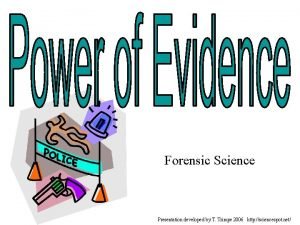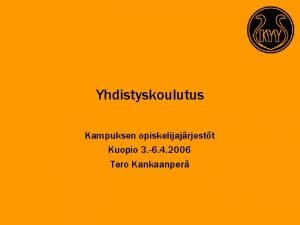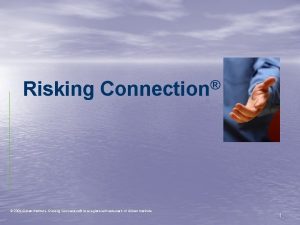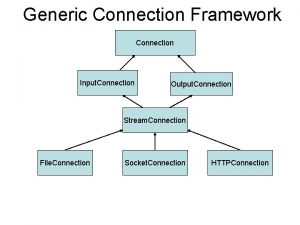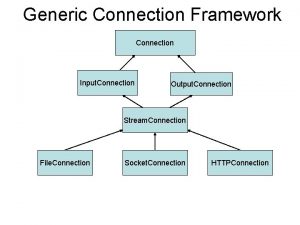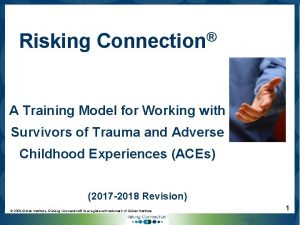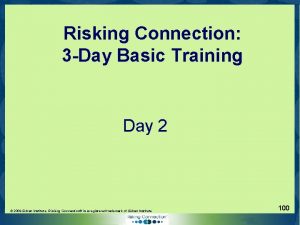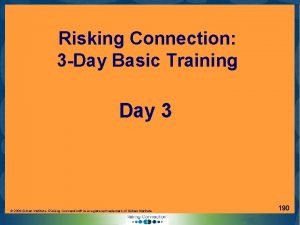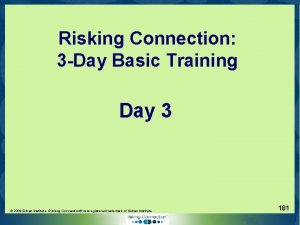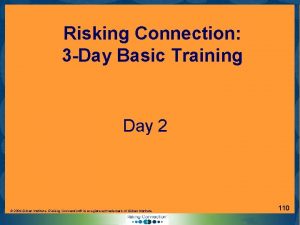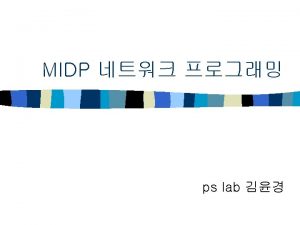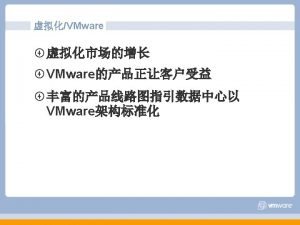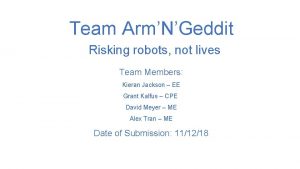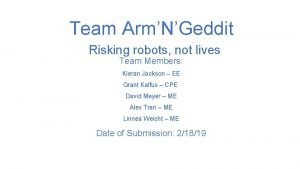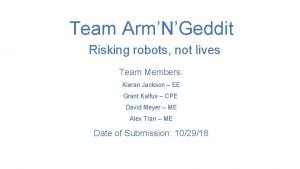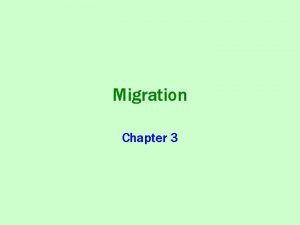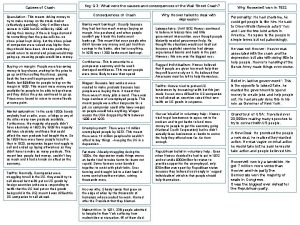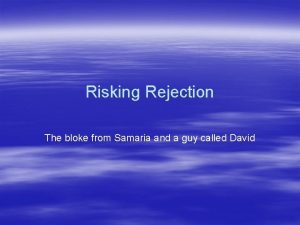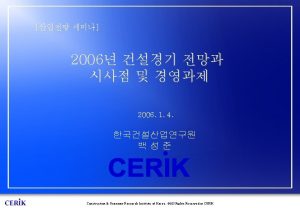Risking Connection 2006 Sidran Institute Risking Connection is



































































































- Slides: 99

Risking ® Connection © 2006 Sidran Institute. Risking Connection® is a registered trademark of Sidran Institute 1

Presented by the Traumatic Stress Institute of Klingberg Family Centers And the Sidran Institute © 2006 Sidran Institute. Risking Connection® is a registered trademark of Sidran Institute 2

A Training Curriculum for Working with Survivors of Childhood Abuse Authors Karen W. Saakvitne, Ph. D. Sarah Gamble, Ph. D. Laurie Anne Pearlman, Ph. D. Beth Tabor Lev, Ph. D. The Sidran Press © 2006 Sidran Institute. Risking Connection® is a registered trademark of Sidran Institute 3

Risking Connection : 3 -Day Basic Training ® Day 1 © 2006 Sidran Institute. Risking Connection® is a registered trademark of Sidran Institute 4

Frame of Training © 2006 Sidran Institute. Risking Connection® is a registered trademark of Sidran Institute 5

Video Star Trek Next Generation © 2006 Sidran Institute. Risking Connection® is a registered trademark of Sidran Institute 6

Origins of Risking Connection From consumer trauma survivors grassroots effort in Maine Mental health services making clients worse, not better Maine and New York launch plan to train public mental health workers in trauma-sensitive treatment Sidran and TREATI – write, field test, disseminate RC curriculum and training program Risking Connection born of consumer advocacy © 2006 Sidran Institute. Risking Connection® is a registered trademark of Sidran Institute 7

Overview of Training Day 1 Topics • Lifelong impact of trauma • Traditional model vs. trauma model • Understanding and applying the trauma framework • Vicarious traumatization (VT) © 2006 Sidran Institute. Risking Connection® is a registered trademark of Sidran Institute 8

Overview of Training Day 2 Topics • Healing attachment and strengthening feeling skills • Frame and boundaries • Using RC principles to manage crisis • Rethinking “manipulation” • Re-enactment • VT and crisis © 2006 Sidran Institute. Risking Connection® is a registered trademark of Sidran Institute 9

Overview of Training Day 3 Topics • Understanding dissociation (optional) • Self-awareness and use of our feelings about clients • Applying RC concepts to treatment programs and organizational practices • Addressing and transforming VT © 2006 Sidran Institute. Risking Connection® is a registered trademark of Sidran Institute 10

What a Risking Connection Approach to Treatment is NOT: • Does NOT mean an absence of limits or rules. • Does NOT mean that staff don’t have or use their authority. • Does NOT mean that staff ignore challenging behaviors. • Is NOT a model of treatment that can only be employed when things are calm and we have plenty of time to intervene. © 2006 Sidran Institute. Risking Connection® is a registered trademark of Sidran Institute 11

Contents of the Curriculum Text (didactic material) Sidebar Text (special topics) Client Clinical Examples Treater Examples Sidebars exercies and reflection Worksheets Bibliography © 2006 Sidran Institute. Risking Connection® is a registered trademark of Sidran Institute 12

Lifelong Impact of Trauma Adverse Childhood Experiences (ACE) Study “The most important study you never heard of. ” Jane Stevens, Acesconnection. com © 2006 Sidran Institute. Risking Connection® is a registered trademark of Sidran Institute 13

Story of the ACE Study Very large sample -- 17, 000 patients at Kaiser Permanent HMO Average 57 High functioning All insured Middle and upper middle class 74% attended college © 2006 Sidran Institute. Risking Connection® is a registered trademark of Sidran Institute Anda et al. , 2006 14

ACE Categories ABUSE AND NEGLECT 1. 2. 3. 4. 5. Emotional abuse Physical abuse Sexual abuse Emotional neglect Physical neglect HOUSEHOLD DYSFUNCTION 6. Mother Treated Violently 7. Household Substance Abuse 8. Household Mental Illness 9. Parental Separation or Divorce 10. Incarcerated Household Member • © 2006 Sidran Institute. Risking Connection® is a registered trademark of Sidran Institute 15

Findings: High Prevalence 40 36, 1 35 30 26 Percentage • 64% at least 1 ACE • 12% 4+ ACEs • 25% households with substance abuse • 25% physical abuse 25 20 15, 9 15 9, 5 10 12, 5 5 0 0 1 2 3 4+ Number of ACEs © 2006 Sidran Institute. Risking Connection® is a registered trademark of Sidran Institute Anda et al. , 2006 16

Findings: High Association to Negative Health Outcomes 60 50 Percentage • Stunning correlations • Linear dose -toresponse relationship 40 Attempted Suicide Alcoholism 30 20 Depression 10 0 0 1 2 3 Number of ACEs © 2006 Sidran Institute. Risking Connection® is a registered trademark of Sidran Institute 4+ Felitti et al. , 1998 17

Findings: High Association to Negative Health Outcomes 60 50 Percentage 4+ vs. 0 ACEs • 6 x more likely to commit suicide • 7 x more likely to be alcoholic • 7 x more like to have sex by 15 • 46 x more like to use injected drugs 40 Attempted Suicide Alcoholism 30 20 Depression 10 0 0 1 2 3 Number of ACEs © 2006 Sidran Institute. Risking Connection® is a registered trademark of Sidran Institute 4+ Felitti et al. , 1998 18

Findings: High Association to Negative Health Outcomes 12 10 Percentage • Negative impacts BEYOND mental health • Repeated stress has lifelong impact • Physiological impact on cellular level 8 6 Heart disease 4 Lung dsease 2 Obesity 0 0 1 2 3 4 Number of ACEs © 2006 Sidran Institute. Risking Connection® is a registered trademark of Sidran Institute Felitti et al. , 1998 19

Findings: High Association to Negative Health Outcomes 12 10 Percentage 4+ vs. 0 ACEs • 2 x more likely to have cancer • 2 x more likely to have heart disease • > 2 x more likely to be obese 8 6 Heart disease 4 Lung dsease 2 Obesity 0 0 1 2 3 4 Number of ACEs © 2006 Sidran Institute. Risking Connection® is a registered trademark of Sidran Institute Felitti et al. , 1998 20

Original Study vs. Incarcerated 70 60 Percentage 50 40 Juvenile Justice, Females Kaiser 30 20 10 0 0 1 2 3 Number of ACEs © 2006 Sidran Institute. Risking Connection® is a registered trademark of Sidran Institute 4 Anda et al. , 2006 Reavis, Looman, Franco, & Rojas, 2013 Baglivio et al. , 2014 21

Original Study vs. Women Raised in Foster Care 80 70 Percentage 60 50 Kaiser 40 Foster care 30 20 10 0 0 1 2 Number of ACEs © 2006 Sidran Institute. Risking Connection® is a registered trademark of Sidran Institute 3 4+ Anda et al. , 2006 Bruskas, 2013 22

If child abuse ended today… If child abuse ended today, in 10 years the jails would be empty and the DSM would be a pamphlet. – adapted from John Briere, Ph. D. © 2006 Sidran Institute. Risking Connection® is a registered trademark of Sidran Institute 23

Why So Important? Trauma is public health epidemic Roots of poor health in childhood trauma unrecognized. Physiological impact of chronic stress/trauma – especially in childhood Intervene early to prevent ACEs/more ACEs Addressing trauma prevents health problems throughout life span TRAUMA-INFORMED CARE!!!! © 2006 Sidran Institute. Risking Connection® is a registered trademark of Sidran Institute 24

What Is Trauma-Informed Care? Services and service settings that recognize the pervasive impact of trauma Services that heal the impact of trauma, rather than make it worse (retraumatization) Systemwide change – paradigm shift © 2006 Sidran Institute. Risking Connection® is a registered trademark of Sidran Institute 25

Underlying Assumptions Traditional Model © 2006 Sidran Institute. Risking Connection® is a registered trademark of Sidran Institute Trauma-Informed Model 26

Underlying Assumptions Traditional Model What’s wrong with you? © 2006 Sidran Institute. Risking Connection® is a registered trademark of Sidran Institute Trauma-Informed Model What happened to you? 27

Underlying Assumptions Traditional Model Priority on Control. © 2006 Sidran Institute. Risking Connection® is a registered trademark of Sidran Institute Trauma-Informed Model Priority on collaboration. Balance ensuring safety and collaboration. 28

Underlying Assumptions (cont’d) Traditional Model Negative behavior viewed as needing to be changed © 2006 Sidran Institute. Risking Connection® is a registered trademark of Sidran Institute Trauma-Informed Model Negative behavior viewed as adaptive. Exists for a reason which we need to figure out 29

Underlying Assumptions (cont’d) Traditional Model Trauma-Informed Model Primary agent of change is relationships Primary agent of change is punishment © 2006 Sidran Institute. Risking Connection® is a registered trademark of Sidran Institute 30

Underlying Assumptions (cont’d) Traditional Model Treater as authority and expert Trauma Model Treater as collaborator © 2006 Sidran Institute. Risking Connection® is a registered trademark of Sidran Institute 31

Underlying Assumptions (cont’d) Traditional Model Trauma-Informed Model Treater expected to be impacted by the work. Strong feelings inevitable. Need to be Treater expected to be talked about and invulnerable. Strong managed. feelings about the work viewed as unprofessional and weak. © 2006 Sidran Institute. Risking Connection® is a registered trademark of Sidran Institute 32

Definitions The Trauma Framework © 2006 Sidran Institute. Risking Connection® is a registered trademark of Sidran Institute 33

What is psychological trauma? Trauma is the unique individual experience of an event or enduring conditions in which: The individual’s ability to integrate his or her emotional experience is overwhelmed; and The individual experiences a threat to life, bodily integrity, or sanity. p. 5 © 2006 Sidran Institute. Risking Connection® is a registered trademark of Sidran Institute 34

Empowerment & Collaboration Key Concepts Empowerment and collaboration challenge survivors’ expectations about relationships. Survivors often fight desperately for control or passively comply. Survivors benefit most when they participate actively in treatment and have control over decisions that affect them. © 2006 Sidran Institute. Risking Connection® is a registered trademark of Sidran Institute 35

Terrence or Tina © 2006 Sidran Institute. Risking Connection® is a registered trademark of Sidran Institute 36

Risking Connection® Framework Childhood Traumatic Events/ACEs Disrupted Development Attachments Body and brain Self capacities: Inner Connection Current Stressor Worthy of Life gs n i l e e F e tolerabl In Feelings Management Acts to Relieve Feelings Retreats, hurts self, or hurts others © 2006 Sidran Institute. Risking Connection® is a registered trademark of Sidran Institute Adaptive: Helps in the moment, hurts in the long run 37

The Impact of Trauma on Attachment © 2006 Sidran Institute. Risking Connection® is a registered trademark of Sidran Institute 38

Risking Connection® Framework Childhood Traumatic Events/ACEs Disrupted Development Attachments Body and brain Self capacities: Inner Connection Current Stressor Worthy of Life gs n i l e e F e tolerabl In Feelings Management Acts to Relieve Feelings Retreats, hurts self, or hurts others © 2006 Sidran Institute. Risking Connection® is a registered trademark of Sidran Institute Adaptive: Helps in the moment, hurts in the long run 39

Attachment Under Normative Conditions Attachment is an essential part of being human. Attachment is the foundation for regulation and management of stress. From early relationships children develop expectations about the nature of relationships. © 2006 Sidran Institute. Risking Connection® is a registered trademark of Sidran Institute 40

Attachment under Normative Conditions (2) Attachment is an innate biological response to stress. Danger/vulnerability Physiological arousal Heightens attachment needs Child sends distress signal Draws attention of caregiver who reestablishes closeness and protection Reunion reduces physiological arousal and emotional distress Return to regulated calm state © 2006 Sidran Institute. Risking Connection® is a registered trademark of Sidran Institute 41

Attachment under Normative Conditions (3) This process happens thousands of times during normal development. Continual rupture and repair of relationship Children, over time, begin to learn to regulate their own distress. Adult distress regulation rooted in childhood. © 2006 Sidran Institute. Risking Connection® is a registered trademark of Sidran Institute 42

Attachment and Attunement Babies grow and develop connections in their brains through attunement Necessary at all stages of life Sense of being seen and known Matching of affect, tone, pace, distance Promotes calming and soothing Develops ability to know self and to self-regulate © 2006 Sidran Institute. Risking Connection® is a registered trademark of Sidran Institute 43

Exercise • Attunement © 2006 Sidran Institute. Risking Connection® is a registered trademark of Sidran Institute 44

Video “Still Face Experiment” Dr. Edward Tronick Harvard University © 2006 Sidran Institute. Risking Connection® is a registered trademark of Sidran Institute 45

Trauma and Attachment “It’s impossible to discuss trauma… without addressing the quality of parental attachment. ” (van der Kolk, 2003) © 2006 Sidran Institute. Risking Connection® is a registered trademark of Sidran Institute 46

Trauma and Attachment (2) Trauma with secure attachment. “Secure attachment is the antidote to trauma. ” (Allen, 1995) Trauma with insecure attachment. Trauma at the hands of attachment figures “Attachment trauma” (Allen, 2001) © 2006 Sidran Institute. Risking Connection® is a registered trademark of Sidran Institute 47

Terrence or Tina: Attachment What are Terrence’s/Tina’s assumptions about relationships? © 2006 Sidran Institute. Risking Connection® is a registered trademark of Sidran Institute 48

The Impact of Trauma on Biology © 2006 Sidran Institute. Risking Connection® is a registered trademark of Sidran Institute 49

Risking Connection® Framework Childhood Traumatic Events/ACEs Disrupted Development Attachments Body and brain Self capacities: Inner Connection Current Stressor Worthy of Life gs n i l e e F e tolerabl In Feelings Management Acts to Relieve Feelings Retreats, hurts self, or hurts others © 2006 Sidran Institute. Risking Connection® is a registered trademark of Sidran Institute Adaptive: Helps in the moment, hurts in the long run 50

Bad News: Trauma changes the brain Images of Brain Activity Non-institutionalized Child Institutionalized Orphan http: //web. snf. org/content/Publications/Brain. Briefings/work. outs. html © 2006 Sidran Institute. Risking Connection® is a registered trademark of Sidran Institute 51

Good News: The Brain Is Changeable Experiencing caring, attuned relationships causes the brain to change and recover. © 2006 Sidran Institute. Risking Connection® is a registered trademark of Sidran Institute 52

How the Nervous System Responds to Danger Signals Something’s wrong! Am I safe? I’ll check it out… The Body Reacts: • Extreme alertness • Non-essential bodily functions stop • Focused thinking to assess danger Safe! Body calms, often with help of supportive others © 2006 Sidran Institute. Risking Connection® is a registered trademark of Sidran Institute Danger! If threat assessed as real, body goes into fight, flight or freeze 53

Malfunctioning Danger Response After chronic trauma, very small triggers can activate the danger response • Echo to old trauma • Hyper-arousal • Extreme alertness • Non-essential bodily functions stop CAN’ T THINK responses e z e e fr r /o d n a t h ig fl t, Extreme figh Rollercoaster from “on” to “shut down” Stuck in “on” © 2006 Sidran Institute. Risking Connection® is a registered trademark of Sidran Institute Numb, “shut down” 54

How Chronic Trauma Impacts the Nervous System Chronically traumatized client: • may be stuck in danger response mode • makes mountains out of molehills • cannot think when stuck in “on” Over time • MANY repetitions do change the brain • Chronically traumatized clients become able to think and problem solve while upset © 2006 Sidran Institute. Risking Connection® is a registered trademark of Sidran Institute 55

Video “Toxic Stress Derails Healthy Development” Center for the Developing Child, Harvard University © 2006 Sidran Institute. Risking Connection® is a registered trademark of Sidran Institute 56

Terrence or Tina: Biology How might Terrence’s/Tina’s traumatic experiences have affected his biology (nervous system and brain)? © 2006 Sidran Institute. Risking Connection® is a registered trademark of Sidran Institute 57

The Impact of Trauma on Feeling Skills (Self Capacities) © 2006 Sidran Institute. Risking Connection® is a registered trademark of Sidran Institute 58

Risking Connection® Framework Childhood Traumatic Events/ACEs Disrupted Development Attachments Body and brain Self capacities: Inner Connection Current Stressor Worthy of Life gs n i l e e F e tolerabl In Feelings Management Acts to Relieve Feelings Retreats, hurts self, or hurts others © 2006 Sidran Institute. Risking Connection® is a registered trademark of Sidran Institute Adaptive: Helps in the moment, hurts in the long run 59

Feelings Skills: Self Capacities Definition: The ability to stay connected to and grounded in one’s sense of self even when one is experiencing strong feelings. The fundamental building blocks of the self. © 2006 Sidran Institute. Risking Connection® is a registered trademark of Sidran Institute 60

The Three Feelings Skills: Self Capacities 1. Inner connection to others 2. Feeling worthy of life 3. Managing feelings © 2006 Sidran Institute. Risking Connection® is a registered trademark of Sidran Institute 61

Risking Connection® Framework Childhood Traumatic Events/ACEs Disrupted Development Attachments Body and brain Self capacities: Inner Connection Current Stressor Worthy of Life gs n i l e e F e tolerabl In Feelings Management Acts to Relieve Feelings Retreats, hurts self, or hurts others © 2006 Sidran Institute. Risking Connection® is a registered trademark of Sidran Institute Adaptive: Helps in the moment, hurts in the long run 62

Inner Connection to Others The ability to form connections with positive others AND To hold onto that connection when the other is not physically present © 2006 Sidran Institute. Risking Connection® is a registered trademark of Sidran Institute 63

How It Feels When Inner Connection Is Impaired Small distances felt as chasms Life is unbearably lonely Separations are felt as forever © 2006 Sidran Institute. Risking Connection® is a registered trademark of Sidran Institute Panic to get and hold attention The mind contains hostile voices, rather than comforting ones 64

When Inner Connection to Others Is Impaired Results in following common behaviors: Extreme reactions to small separations Extreme behaviors to keep others engaged and avoid separation Putting self at risk to maintain connections and not be alone © 2006 Sidran Institute. Risking Connection® is a registered trademark of Sidran Institute 65

When Inner Connection Is Strong One can sooth self when alone One can think of someone who cares and gain comfort One can use transitional objects to gain comfort One can be alone without feeling lonely © 2006 Sidran Institute. Risking Connection® is a registered trademark of Sidran Institute 66

Risking Connection® Framework Childhood Traumatic Events/ACEs Disrupted Development Attachments Body and brain Self capacities: Inner Connection Current Stressor Worthy of Life gs n i l e e F e tolerabl In Feelings Management Acts to Relieve Feelings Retreats, hurts self, or hurts others © 2006 Sidran Institute. Risking Connection® is a registered trademark of Sidran Institute Adaptive: Helps in the moment, hurts in the long run 67

Worthy of Life The ability to hold onto a sense of oneself as deserving and worthwhile. © 2006 Sidran Institute. Risking Connection® is a registered trademark of Sidran Institute 68

Worthy of Life: Guilt versus Shame GUILT - feeling that you are a worthwhile person who has done something wrong. SHAME - feeling that you are, at your core, a worthless person, without redemption. © 2006 Sidran Institute. Risking Connection® is a registered trademark of Sidran Institute 69

Worthy of Life: A Shame-Based Client Shame-based clients find it intolerable to be visible or exposed because others will see the hateful inner core they feel within themselves. © 2006 Sidran Institute. Risking Connection® is a registered trademark of Sidran Institute 70

Worthy of Life: A Shame-Based Client So they…. Act to display or confirm the image of themselves. Invite rejection to get it over with Distrust affection and approval (“If you knew the real me, you wouldn’t like me. ”) © 2006 Sidran Institute. Risking Connection® is a registered trademark of Sidran Institute 71

Worthy of Life: A Shame-Based Client So they… Avoid connection because they are certain of rejection Are paralyzed when there are problems in relationships © 2006 Sidran Institute. Risking Connection® is a registered trademark of Sidran Institute 72

Worthy of Life: A Shame-Based Client So they… Use aggression to prevent or deflect exposure of shame Attack weakness wherever they see it Don’t take responsibility for their actions © 2006 Sidran Institute. Risking Connection® is a registered trademark of Sidran Institute 73

Worthy of Life: A Shame-Based Client The antidote to shame is: Connection Be aware of shame triggering situations and respond with empathy. © 2006 Sidran Institute. Risking Connection® is a registered trademark of Sidran Institute 74

Risking Connection® Framework Childhood Traumatic Events/ACEs Disrupted Development Attachments Body and brain Self capacities: Inner Connection Current Stressor Worthy of Life gs n i l e e F e tolerabl In Feelings Management Acts to Relieve Feelings Retreats, hurts self, or hurts others © 2006 Sidran Institute. Risking Connection® is a registered trademark of Sidran Institute Adaptive: Helps in the moment, hurts in the long run 75

Feelings Management The ability to soothe oneself when having strong feelings. Identifying Feelings Tolerating Feelings Modulating Feelings Integrating Feelings © 2006 Sidran Institute. Risking Connection® is a registered trademark of Sidran Institute 76

Feelings Management Specific feelings management skills are taught -- usually within relationships. © 2006 Sidran Institute. Risking Connection® is a registered trademark of Sidran Institute 77

Exercise If Self Capacities Could Speak, What Would They Say… © 2006 Sidran Institute. Risking Connection® is a registered trademark of Sidran Institute 78

Terrence or Tina: Feelings skills Which self-statements (on Worksheet: If Self Capacities Could Speak) would best describe Terrence’s/Tina’s beliefs about himself? © 2006 Sidran Institute. Risking Connection® is a registered trademark of Sidran Institute 79

Symptoms as Adaptations © 2006 Sidran Institute. Risking Connection® is a registered trademark of Sidran Institute 80

Risking Connection® Framework Childhood Traumatic Events/ACEs Disrupted Development Attachments Body and brain Self capacities: Inner Connection Current Stressor Worthy of Life gs n i l e e F e tolerabl In Feelings Management Acts to Relieve Feelings Retreats, hurts self, or hurts others © 2006 Sidran Institute. Risking Connection® is a registered trademark of Sidran Institute Adaptive: Helps in the moment, hurts in the long run 81

Symptoms/Behaviors Are Adaptations Symptoms/behaviors are ways clients have learned to adapt to (cope with) intolerable feelings, memories, and situations in their lives. Symptoms/behaviors help the child in the moment -despite long-term negative consequences. © 2006 Sidran Institute. Risking Connection® is a registered trademark of Sidran Institute 82

© 2006 Sidran Institute. Risking Connection® is a registered trademark of Sidran Institute 83

Implications of Viewing Symptoms as Adaptations Strength-based, not deficit-based. Helps treater to not take client’s negative behaviors personally. Reduces shame and blame -- clients often come in expecting to be blamed. © 2006 Sidran Institute. Risking Connection® is a registered trademark of Sidran Institute 84

Implications of Viewing Symptoms as Adaptations (2) Allies treater with client to solve a problem together. Assumes, at any moment, person doing the best she can. © 2006 Sidran Institute. Risking Connection® is a registered trademark of Sidran Institute 85

Terrence or Tina: Behavior How is Terrence’s/Tina’s behavior adaptive? How does it help in the moment? © 2006 Sidran Institute. Risking Connection® is a registered trademark of Sidran Institute 86

Terrence or Tina What does Terrence/Tina need to heal? © 2006 Sidran Institute. Risking Connection® is a registered trademark of Sidran Institute 87

Trauma Treatment Does Not Equal “Uncovering” Trauma work does not necessarily mean uncovering (remembering, discussing) memories. First, early work emphasizes creating a therapeutic (RICH) relationship and establishing safety (through developing feelings skills). Then, later (often much later) work focuses on understanding present impact of past traumatic experiences. People can understand the impact of the past without remembering all the details. © 2006 Sidran Institute. Risking Connection® is a registered trademark of Sidran Institute 88

Exercise Applying the trauma framework © 2006 Sidran Institute. Risking Connection® is a registered trademark of Sidran Institute 89

Exploring How We Were Parented © 2006 Sidran Institute. Risking Connection® is a registered trademark of Sidran Institute 90

Exercise • List 3 ways you think your parents/guardians did a good job of parenting you. • List 3 ways you parent or would parent differently from how you were parented. • List 2 things you learned growing up about managing problem behavior. • How does management of problem behavior at your agency compare to what you learned growing up? • What are 3 qualities that make you a positive caregiving figure for the clients you serve? © 2006 Sidran Institute. Risking Connection® is a registered trademark of Sidran Institute 91

Introduction to Vicarious Traumatization © 2006 Sidran Institute. Risking Connection® is a registered trademark of Sidran Institute 92

Vicarious Traumatization How this work will change you VT refers to the negative changes in the helper as a result of empathically engaging with and feeling, or being, responsible for traumatized clients. Laurie Pearlman, Ph. D Kay Saakvitne, Ph. D. © 2006 Sidran Institute. Risking Connection® is a registered trademark of Sidran Institute 93

Vicarious Traumatization VT is an inescapable effect of trauma work -- an occupational hazard. It is neither the fault of the client, nor a result of “weakness” on the part of the treater. VT damages hope and optimism, which are essential gifts we bring to our work. © 2006 Sidran Institute. Risking Connection® is a registered trademark of Sidran Institute 94

Vicarious Traumatization (2) The single most important factor in the success or failure of trauma work is the attention paid to the experience and needs of the helper. Addressing VT is an ethical imperative. © 2006 Sidran Institute. Risking Connection® is a registered trademark of Sidran Institute 95

How VT Changes Us VT can impact: Our identity, worldview, and spirituality Our core beliefs about safety, trust, esteem, control, and intimacy Our own ability to manage feelings © 2006 Sidran Institute. Risking Connection® is a registered trademark of Sidran Institute 96

How VT Changes Us (2) Our bodily feelings and experience including our sexuality Our sense of meaning and hope © 2006 Sidran Institute. Risking Connection® is a registered trademark of Sidran Institute 97

Vicarious Traumatization: Exercise Write down 3 signs of vicarious traumatization that you are aware of in yourself. Write down 3 ways in which you are positively impacted by the work you do. What benefits do you experience from the work? © 2006 Sidran Institute. Risking Connection® is a registered trademark of Sidran Institute 98

Vicarious Traumatization Grief wounds more deeply in solitude; tears are less bitter when mingled with other tears. Agememnon Seneca © 2006 Sidran Institute. Risking Connection® is a registered trademark of Sidran Institute 99
 Going for the look but risking discrimination
Going for the look but risking discrimination A 325
A 325 Slip critical connection vs bearing connection
Slip critical connection vs bearing connection Text to world connections examples
Text to world connections examples Slip critical connection vs bearing connection
Slip critical connection vs bearing connection Banking ombudsman scheme 2006
Banking ombudsman scheme 2006 Boardworks ltd 2006
Boardworks ltd 2006 Amc 8 2010
Amc 8 2010 Commercial practice definition
Commercial practice definition 2006 emo
2006 emo 'xxxxxx
'xxxxxx Digital image 2006
Digital image 2006 Reporte sura
Reporte sura The moon in 5/8/2006
The moon in 5/8/2006 09 juli 2006
09 juli 2006 Luthans 2006
Luthans 2006 Maturita 2007
Maturita 2007 Http://sciencespot.net/
Http://sciencespot.net/ Jane eyre 2006 cast
Jane eyre 2006 cast Sentencia c-355
Sentencia c-355 Biologijos egzamino taskai
Biologijos egzamino taskai May 14 2006
May 14 2006 2006 kids
2006 kids Ph.margary
Ph.margary Hakikat pkn menurut permendiknas no 22 tahun 2006
Hakikat pkn menurut permendiknas no 22 tahun 2006 A real friend 2006
A real friend 2006 Gudi padwa 2006
Gudi padwa 2006 Sni 3554 2015
Sni 3554 2015 Monarch awards 2006
Monarch awards 2006 2006
2006 02062006
02062006 Boardworks ltd 2006
Boardworks ltd 2006 18/11/2006 lunaf
18/11/2006 lunaf Copyright 2006
Copyright 2006 2006
2006 Decreto 1011 de 2006
Decreto 1011 de 2006 The customer is always right 2006
The customer is always right 2006 Pelan induk pembangunan pendidikan
Pelan induk pembangunan pendidikan Vision de una empresa de comidas rapidas
Vision de una empresa de comidas rapidas Gracias por su atencion
Gracias por su atencion Pam contract 2006
Pam contract 2006 2006
2006 Syawal 2006
Syawal 2006 Tems drive test training
Tems drive test training Ckm 2006
Ckm 2006 Clasificacion johner y wruhs
Clasificacion johner y wruhs Nasa october 29 2006
Nasa october 29 2006 T. trimpe 2006 http://sciencespot.net/
T. trimpe 2006 http://sciencespot.net/ Jana crystallography
Jana crystallography T.trimpe 2006 http sciencespot.net
T.trimpe 2006 http sciencespot.net Matab senaei 2006
Matab senaei 2006 T.trimpe 2003 http //sciencespot.net/ answers
T.trimpe 2003 http //sciencespot.net/ answers Mat 4 razred
Mat 4 razred T. trimpe 2006 http //sciencespot.net/
T. trimpe 2006 http //sciencespot.net/ Gina 2006
Gina 2006 Astronomy picture of the day march 29 2006
Astronomy picture of the day march 29 2006 T.trimpe 2006 http sciencespot.net
T.trimpe 2006 http sciencespot.net Legge provinciale 3 2006
Legge provinciale 3 2006 2006 mcgraw-hill ryerson limited
2006 mcgraw-hill ryerson limited Boardworks ltd 2006
Boardworks ltd 2006 Scott ransom 2006
Scott ransom 2006 Picture nasa took on feb 14 2006
Picture nasa took on feb 14 2006 Pengiktirafan ukm 2006
Pengiktirafan ukm 2006 Nice 2006
Nice 2006 April 2006 calendar
April 2006 calendar Maturita 2006
Maturita 2006 T.trimpe 2006
T.trimpe 2006 Ot ibr 01/2006
Ot ibr 01/2006 Sentencia c-355 de 2006
Sentencia c-355 de 2006 Actuaries act 2006
Actuaries act 2006 2006
2006 31 desember 2006
31 desember 2006 Understanding human communication 14th edition
Understanding human communication 14th edition T. trimpe 2006 http //sciencespot.net/ answer key
T. trimpe 2006 http //sciencespot.net/ answer key Http://sciencespot.net
Http://sciencespot.net January 13 2006 calendar
January 13 2006 calendar 4 teras utama misi nasional 2006 hingga 2020
4 teras utama misi nasional 2006 hingga 2020 2006-1971
2006-1971 Copyright 2006
Copyright 2006 Hối phiếu
Hối phiếu Importancia del apec
Importancia del apec T. trimpe 2006 http://sciencespot.net/
T. trimpe 2006 http://sciencespot.net/ 2006 ipod
2006 ipod 2006
2006 6 november 2006
6 november 2006 Xxxx 2006
Xxxx 2006 T. trimpe 2006 http://sciencespot.net/
T. trimpe 2006 http://sciencespot.net/ Menghitung taksiran kerugian piutang
Menghitung taksiran kerugian piutang Jass 2006
Jass 2006 2006
2006 Lee 2006
Lee 2006 Sciencespot.net
Sciencespot.net T trimpe 2006 http //sciencespot.net/ answer key
T trimpe 2006 http //sciencespot.net/ answer key Takahashi yamanaka 2006
Takahashi yamanaka 2006 2 mars 2006
2 mars 2006 Regulation 1107/2006
Regulation 1107/2006 May 25 2006
May 25 2006 T. trimpe 2006 http //sciencespot.net/
T. trimpe 2006 http //sciencespot.net/ Ramadan 2006
Ramadan 2006 6/4/2006
6/4/2006
